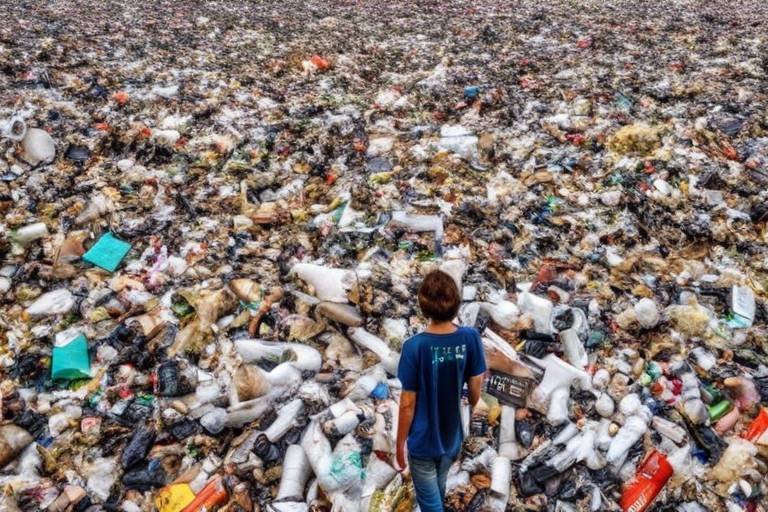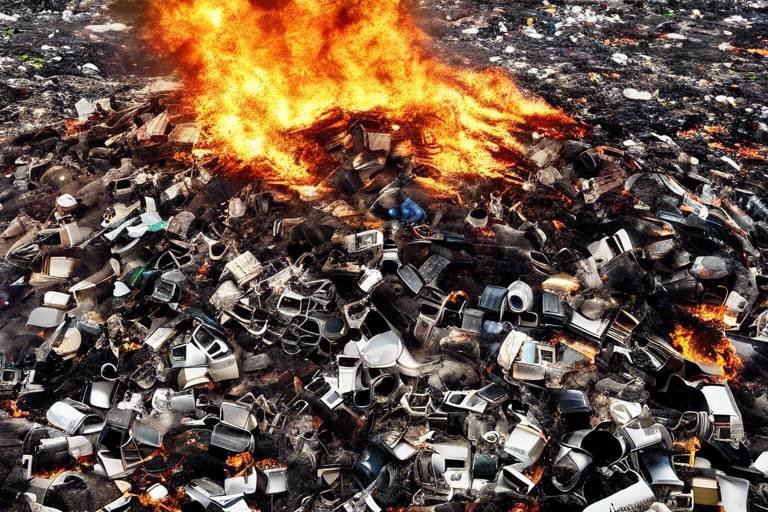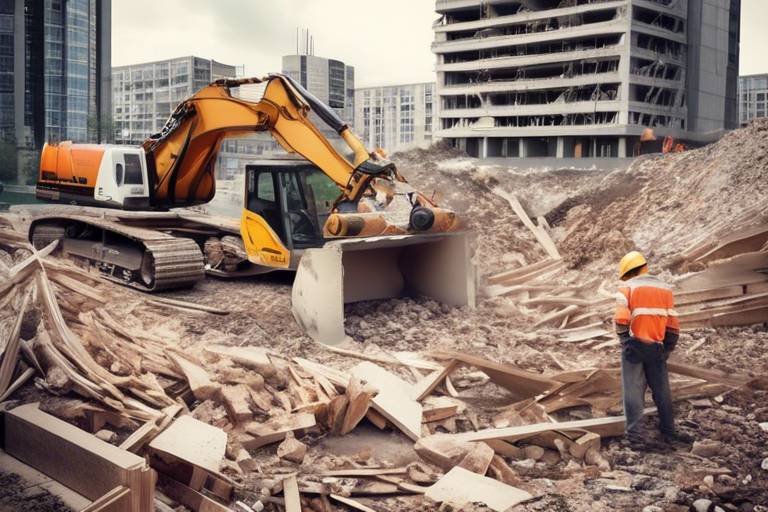The Role of Public Spaces in Reducing Waste
Public spaces are more than just open areas in our cities; they are the lifeblood of community interaction, environmental awareness, and sustainable practices. Imagine walking through a vibrant park filled with people enjoying nature, children playing, and families gathering for picnics. These spaces not only provide a sanctuary from the hustle and bustle of urban life but also play a crucial role in reducing waste. By promoting responsible waste management practices and fostering community engagement, public spaces become essential in our fight against waste pollution.
One of the most significant ways public spaces contribute to waste reduction is through their ability to educate and engage the community. When people come together in parks, plazas, and other communal areas, they are more likely to participate in discussions about sustainability and waste management. This engagement can take many forms, from organized clean-up events to educational workshops that teach residents about the importance of recycling and composting. The more we interact with our environment, the more we understand our impact on it, leading to more responsible behaviors.
Furthermore, the design of these public spaces can greatly influence how waste is managed. For instance, incorporating features like recycling bins, composting stations, and waste sorting areas encourages individuals to dispose of their waste responsibly. It’s like setting the stage for a performance; when the right elements are in place, people are more likely to act in ways that support sustainability. By making waste disposal easy and accessible, public spaces can significantly reduce littering and promote a culture of cleanliness.
In addition to physical infrastructure, public spaces can serve as platforms for innovative waste solutions. Think about smart waste bins that can monitor waste levels and notify waste management services when they need to be emptied. These technological advancements not only optimize waste collection but also minimize overflow and litter, which can be a significant problem in busy urban areas. By integrating such innovations, public spaces can lead the way in demonstrating how we can effectively manage waste in our communities.
Ultimately, the role of public spaces in reducing waste goes beyond mere aesthetics or recreational value; it is about fostering a sense of community responsibility. When individuals feel a connection to their environment, they are more likely to take action to protect it. This sense of ownership can be cultivated through community partnerships, where local governments, organizations, and residents come together to create a shared vision for sustainable practices. By working collaboratively, we can maximize the potential of public spaces to not only reduce waste but also enhance the overall quality of life in our communities.
- How do public spaces contribute to waste reduction?
Public spaces encourage community engagement and provide infrastructure for responsible waste disposal, such as recycling bins and composting stations. - What role does community involvement play in waste management?
Community involvement fosters a sense of ownership and responsibility, leading to more sustainable practices and less waste generation. - Can the design of public spaces influence waste management behaviors?
Yes, incorporating features like waste sorting stations and eco-friendly materials can promote responsible disposal practices. - What are some innovative solutions for waste management in public spaces?
Smart waste bins and composting facilities are examples of innovative solutions that enhance waste management efficiency.

Understanding Public Spaces
Public spaces are more than just open areas; they are the lifeblood of our communities, designed to be accessible to everyone, regardless of age or background. Think of them as the communal living rooms of our cities, where people gather to connect, engage, and enjoy the environment around them. These spaces can include parks, plazas, streets, and waterfronts, all of which play a critical role in shaping urban life. They serve as vital components of urban infrastructure, fostering community interaction and promoting environmental awareness. By providing platforms for socialization and recreation, public spaces significantly influence waste reduction behaviors.
When we talk about waste reduction, it’s essential to recognize how these spaces can be designed and utilized to encourage sustainable practices. For instance, when a park is equipped with recycling bins and composting stations, it sends a clear message that waste matters. This simple act of providing the right tools can lead to a shift in community behavior, making individuals more conscious of their waste disposal choices. The presence of such facilities not only provides convenience but also instills a sense of responsibility among visitors, encouraging them to think twice before littering.
Moreover, public spaces often serve as venues for community events that focus on sustainability. These events can range from local farmers' markets to environmental workshops, all aimed at educating the public about the importance of reducing waste. When people come together in these spaces, they share ideas and practices that can lead to a collective transformation in how waste is perceived and managed. It's like planting seeds of change that flourish through community engagement and collaboration.
In summary, understanding public spaces means recognizing their multifaceted role in our lives. They are not just physical locations; they are essential tools for promoting sustainability, encouraging community engagement, and ultimately driving responsible waste management practices. As we continue to develop our urban environments, it’s crucial to prioritize the integration of these spaces into our waste reduction strategies, ensuring that they serve as effective catalysts for positive change.

Benefits of Green Spaces
When we think about green spaces, we often picture parks, gardens, and tree-lined streets that beautify our neighborhoods. But their benefits extend far beyond aesthetics. Green spaces are essential for promoting a healthier environment and community. They serve as a sanctuary for biodiversity, helping to maintain ecological balance while also providing a plethora of advantages to urban dwellers.
One of the most significant ecological benefits of green spaces is their role in natural waste management. Plants and trees absorb carbon dioxide and release oxygen, improving air quality and combating climate change. Moreover, they act as natural filters, trapping dust and pollutants, which significantly reduces the amount of waste entering our atmosphere. This is akin to having a giant air purifier in our cities, tirelessly working to keep our environment clean.
In addition to their ecological contributions, green spaces have a profound impact on community well-being. They provide a space for recreational activities, social interactions, and relaxation. Studies have shown that spending time in nature can reduce stress, enhance mood, and improve overall mental health. Imagine having a local park where families can gather for picnics, children can play freely, and neighbors can connect. This sense of community fosters a culture of responsible waste management, as people tend to take better care of their surroundings when they feel a sense of ownership.
Furthermore, green spaces encourage sustainable practices among residents. For instance, community gardens not only beautify neighborhoods but also promote the idea of growing food locally, reducing the need for packaged goods and the waste that comes with them. By participating in these initiatives, individuals learn the importance of reducing, reusing, and recycling, which are vital components of effective waste management.
To summarize, the benefits of green spaces are multifaceted. They not only contribute to ecological health and community well-being but also play a crucial role in fostering sustainable practices. As we continue to develop urban areas, it’s essential to prioritize the integration of green spaces into our cities. After all, a greener city is a cleaner city, and it’s up to us to cultivate that environment.
- What are the main benefits of green spaces? Green spaces improve air quality, enhance mental health, promote community interaction, and encourage sustainable practices.
- How do green spaces contribute to waste reduction? They promote recycling, reduce the need for packaged goods, and foster a sense of community responsibility towards waste management.
- Can green spaces help combat climate change? Yes, they absorb carbon dioxide and release oxygen, acting as natural air filters and reducing pollution.
- How can communities create more green spaces? Communities can advocate for parks, community gardens, and tree planting initiatives, often collaborating with local governments and organizations.

Community Engagement Initiatives
Community engagement initiatives are the heartbeat of transforming public spaces into vibrant hubs of environmental stewardship. When residents come together to participate in activities aimed at reducing waste, they not only enhance their surroundings but also foster a sense of belonging and responsibility. Just imagine a neighborhood park bustling with laughter and teamwork as families and friends unite for a common cause—keeping their environment clean. These initiatives can take many forms, from organized clean-up drives to educational workshops that empower individuals with knowledge about sustainable practices.
One of the most impactful ways to engage the community is through organized clean-up events. These events are not just about picking up trash; they are about instilling a sense of ownership among participants. When community members see the direct impact of their efforts, they are more likely to adopt sustainable habits in their daily lives. For instance, after a successful clean-up, participants often express pride in their work, and this pride can lead to long-term behavioral changes. It's like planting a seed; once it takes root, it grows into a tree of awareness and responsibility.
Additionally, educational workshops play a crucial role in these initiatives. They serve as platforms where community members can learn about effective waste management techniques, such as the principles of reducing, reusing, and recycling. These workshops can cover a variety of topics, including:
- How to create a composting system at home
- Understanding the importance of recycling and how to do it correctly
- Innovative ways to reduce waste in daily life
By equipping residents with practical knowledge, these workshops help to cultivate a culture of sustainability. Participants leave feeling inspired and ready to make a difference in their households and communities. Moreover, the social aspect of these events cannot be overlooked. They provide an opportunity for neighbors to connect, share ideas, and collaborate on future projects, thereby strengthening community bonds.
In conclusion, community engagement initiatives are essential in promoting responsible waste management practices. By actively involving residents in clean-up events and educational workshops, public spaces can become catalysts for change. They not only reduce waste but also nurture a community spirit that encourages ongoing environmental stewardship. So, the next time you see a call for volunteers in your local park, consider joining in. After all, every little effort counts, and together, we can create a cleaner, greener world.
Q: What are community engagement initiatives?
A: Community engagement initiatives are activities designed to involve residents in environmental stewardship and waste reduction efforts within public spaces.
Q: How can I get involved in local clean-up events?
A: You can check with your local community center, environmental organizations, or social media groups for upcoming clean-up events in your area.
Q: What are some benefits of participating in educational workshops?
A: Educational workshops provide valuable knowledge on waste management practices, inspire sustainable habits, and offer opportunities to connect with like-minded individuals in your community.
Q: How do these initiatives impact waste reduction?
A: By actively engaging community members in clean-up efforts and educational programs, these initiatives promote responsible waste disposal practices and encourage long-term behavioral changes that lead to reduced waste generation.

Organized Clean-Up Events
Organized clean-up events are not just about picking up litter; they are vibrant gatherings that breathe life into communities while fostering a sense of **ownership** and **responsibility**. Imagine a sunny Saturday morning where neighbors come together, armed with gloves and trash bags, united by a common goal: to beautify their shared environment. These events serve as a powerful reminder that **collective action** can lead to significant change. Not only do they help clear debris from streets, parks, and waterways, but they also cultivate a spirit of camaraderie and shared purpose among participants.
During these events, community members often engage in lively conversations, share stories, and develop friendships, all while making a tangible impact on their surroundings. The act of cleaning up becomes a **catalyst for community bonding**, transforming strangers into friends who share a commitment to maintaining a cleaner, greener space. Furthermore, organized clean-up events can serve as a platform for educating participants about the importance of waste reduction and proper disposal methods. For instance, volunteers might learn about the types of waste that can be recycled or composted, empowering them to make more informed choices in their daily lives.
To maximize the effectiveness of these clean-up events, organizers often collaborate with local businesses, schools, and environmental organizations. This partnership can lead to increased participation and support, as businesses may provide supplies or refreshments, while schools can encourage students to join in as part of their community service projects. The involvement of various stakeholders not only enhances the event's reach but also cultivates a broader understanding of environmental stewardship across different age groups.
In addition to beautifying public spaces, organized clean-up events can have a measurable impact on waste reduction. For instance, a study conducted in a local park showed that after a series of clean-up events, littering decreased by **40%**, demonstrating that community engagement can lead to lasting behavioral change. Moreover, these events often serve as a springboard for ongoing initiatives, such as regular community clean-up days or the establishment of recycling programs. By fostering a culture of **responsibility**, communities can significantly reduce waste generation and promote a sustainable lifestyle.
In conclusion, organized clean-up events are a vital component of waste reduction strategies in public spaces. They not only address immediate litter issues but also build community ties and promote long-term environmental awareness. So, why not grab a friend, roll up your sleeves, and join or organize a clean-up event in your neighborhood? Together, we can make a difference, one piece of litter at a time!
- What should I bring to a clean-up event? It's best to wear comfortable clothes and sturdy shoes. Bring gloves, a reusable water bottle, and any tools like trash grabbers if you have them!
- Are clean-up events suitable for children? Absolutely! Clean-up events can be a fun and educational experience for children, teaching them about environmental responsibility.
- How do I find a clean-up event in my area? Check local community boards, social media groups, or environmental organizations' websites for upcoming events.

Educational Workshops
Educational workshops in public spaces serve as a dynamic platform for community members to gather, learn, and engage in meaningful discussions about waste management. These workshops are not just about imparting knowledge; they are about creating a vibrant community culture that values sustainability and responsible practices. Imagine a sunny Saturday afternoon, where families come together in a local park, listening to an expert share tips on how to reduce waste in their daily lives. The atmosphere is filled with enthusiasm and curiosity, as participants discover practical ways to make a difference.
These workshops often cover a range of topics, including the principles of reduce, reuse, and recycle. Attendees learn about the impact of waste on the environment and the importance of making conscious choices. For instance, participants might engage in hands-on activities that demonstrate how to repurpose everyday items, turning what would be trash into treasure. By fostering a sense of creativity, these workshops inspire individuals to think outside the box and explore innovative solutions to waste problems.
Moreover, the interactive nature of these workshops encourages dialogue among participants. They can share their experiences, challenges, and successes in waste reduction, creating a supportive network that extends beyond the workshop itself. This exchange of ideas can lead to the formation of community groups dedicated to ongoing environmental initiatives, amplifying the workshop's impact.
To illustrate the effectiveness of these workshops, consider the following table that highlights key outcomes from recent educational initiatives:
| Workshop Topic | Participants | Waste Reduction Techniques Learned | Follow-Up Actions |
|---|---|---|---|
| Composting Basics | 50 | Kitchen waste composting, benefits of compost | 40 participants started home composting |
| DIY Upcycling | 30 | Creative reuse of plastics, fabrics | 15 participants formed an upcycling group |
| Recycling Right | 60 | Understanding recycling symbols, local recycling rules | Increased recycling rates in the community |
In conclusion, educational workshops in public spaces not only equip individuals with valuable knowledge but also foster a sense of community and shared responsibility for the environment. By participating in these workshops, attendees become ambassadors for waste reduction, spreading awareness and inspiring others to join the movement towards a more sustainable future. So, next time you see a workshop in your local park, don’t hesitate to join in; your involvement could be the spark that ignites a larger change in your community!
- What topics are typically covered in educational workshops? Workshops often cover topics like composting, recycling, and upcycling.
- Who can attend these workshops? These workshops are open to everyone, regardless of age or background.
- How can I find workshops in my area? Check local community centers, parks, or environmental organizations for upcoming workshops.
- Are these workshops free? Many workshops are free, but some may have a small fee to cover materials.

Waste Management Infrastructure
When we think about public spaces, the beauty of parks and plazas often comes to mind, but there’s another essential aspect that plays a crucial role in making these areas sustainable: . This infrastructure includes elements like recycling bins, composting stations, and waste sorting facilities, all designed to encourage responsible disposal practices. Imagine walking through your local park and seeing clearly labeled bins that make it easy to separate recyclables from regular trash. This simple act can significantly reduce littering and promote a culture of sustainability.
Having proper waste management infrastructure in public spaces does more than just keep the area clean; it sends a powerful message to the community about the importance of responsible waste disposal. When people see that their environment is equipped with the tools they need to manage waste effectively, they are more likely to engage in sustainable practices. For instance, a park with well-placed recycling bins can increase the recycling rate significantly, as people are more inclined to recycle when it’s convenient. Studies have shown that when recycling bins are placed alongside regular trash bins, the rate of recycling can increase by as much as 30%.
Moreover, the presence of composting stations can transform organic waste into valuable resources. By composting food scraps and yard waste, communities can reduce the amount of waste sent to landfills while simultaneously enriching the soil in parks and gardens. This not only helps in waste reduction but also promotes biodiversity and enhances the overall beauty of public spaces. To illustrate the impact of waste management infrastructure, consider the following table:
| Type of Infrastructure | Impact on Waste Reduction |
|---|---|
| Recycling Bins | Increases recycling rates by up to 30% |
| Composting Stations | Reduces organic waste and enriches soil |
| Waste Sorting Facilities | Improves overall waste management efficiency |
In addition to these physical structures, it's essential to consider the role of education in conjunction with waste management infrastructure. Providing information about how to use these facilities properly can make a significant difference. For example, signage that explains what can and cannot be recycled, as well as tips for composting, can empower community members to take action. When people understand the impact of their choices, they are more likely to participate actively in waste reduction efforts.
Ultimately, the integration of effective waste management infrastructure in public spaces is not just about keeping the environment clean; it’s about fostering a community culture that values sustainability. By providing the necessary tools and education, we can create an environment where responsible waste management becomes second nature. So, the next time you visit a public space, take a moment to appreciate the behind-the-scenes efforts that make it possible for us to enjoy these areas while minimizing our environmental footprint.
- What is waste management infrastructure? Waste management infrastructure refers to the systems and facilities that support the collection, recycling, composting, and disposal of waste in public spaces.
- How does waste management infrastructure promote sustainability? By providing accessible recycling and composting options, it encourages individuals to dispose of waste responsibly, thus reducing litter and promoting recycling.
- Can community involvement improve waste management efforts? Absolutely! Community engagement through clean-up events and educational workshops can significantly enhance the effectiveness of waste management infrastructure.

Impact of Design on Waste Reduction
The design of public spaces is not just about aesthetics; it plays a crucial role in shaping our behaviors and attitudes towards waste management. When we think about public spaces, we often envision parks, plazas, and community centers bustling with activity. However, the underlying design elements can significantly influence how we interact with these environments and, consequently, how we handle waste. Imagine walking through a beautifully landscaped park with strategically placed recycling bins and compost stations. Doesn't it make you want to dispose of your waste responsibly? This is the power of thoughtful design.
Incorporating features that promote sustainability can create a ripple effect, encouraging individuals to adopt more responsible waste disposal habits. For example, public spaces designed with waste sorting stations not only facilitate proper disposal but also educate users on the importance of recycling. When people see clear signage and accessible sorting options, they are more likely to engage in responsible waste practices. This design approach transforms waste management from a chore into a community norm.
Moreover, using eco-friendly materials in the construction of public spaces can further enhance their impact on waste reduction. For instance, utilizing recycled materials for benches, walkways, and signage not only minimizes the waste generated during construction but also sends a powerful message about sustainability. When communities prioritize eco-friendly design, they cultivate a culture of environmental stewardship that resonates with residents and visitors alike.
To illustrate the impact of design on waste reduction, consider the following table that outlines various design features and their corresponding benefits:
| Design Feature | Benefit |
|---|---|
| Waste Sorting Stations | Encourages proper waste disposal and recycling. |
| Composting Facilities | Reduces organic waste and promotes composting education. |
| Eco-Friendly Materials | Minimizes waste during construction and promotes sustainability. |
| Interactive Signage | Educates users on waste management practices. |
In addition to these features, innovative solutions such as smart waste bins are emerging as game-changers in waste management within public spaces. These bins can monitor waste levels and notify waste management services when they need to be emptied, thereby optimizing collection routes and reducing unnecessary trips. This not only saves resources but also minimizes the carbon footprint associated with waste collection.
Ultimately, the impact of design on waste reduction is profound. By creating public spaces that prioritize sustainability and responsible waste management, we can foster a community culture that values environmental stewardship. It’s about more than just reducing waste; it’s about inspiring individuals to take action and make conscious choices that benefit the planet. So the next time you enjoy a stroll through your local park, take a moment to appreciate the thoughtfulness behind its design—and consider how you can contribute to its sustainability.
- How can public space design influence community behavior regarding waste? Public space design can encourage responsible waste disposal through features like recycling bins and educational signage, making it easier for individuals to engage in sustainable practices.
- What are some examples of innovative waste management solutions in public spaces? Examples include smart waste bins that monitor fill levels and composting facilities that promote organic waste reduction.
- Why is the use of eco-friendly materials important in public space design? Using eco-friendly materials minimizes waste during construction, promotes sustainability, and sets a positive example for the community.

Innovative Waste Solutions
In our quest for a cleaner and more sustainable environment, are emerging as game-changers in public spaces. These solutions not only enhance waste management efficiency but also inspire communities to engage in responsible waste disposal practices. Imagine walking through a park and encountering smart waste bins equipped with sensors that monitor fill levels and automatically notify waste collection services when they need to be emptied. This technology minimizes overflow and litter, ensuring that public spaces remain clean and inviting.
Moreover, the integration of composting facilities in parks and community gardens serves a dual purpose: it reduces organic waste while creating nutrient-rich compost that can be used to enrich the soil. This not only minimizes landfill waste but also promotes a circular economy where waste is transformed into a resource. By setting up these facilities, communities can significantly cut down on the amount of organic waste they produce, contributing to a healthier planet.
Another innovative solution is the use of recycling kiosks that provide incentives for proper waste disposal. These kiosks reward individuals for recycling by offering points or discounts at local businesses. This not only encourages responsible behavior but also fosters a sense of community as people come together to contribute towards a common goal of reducing waste. Imagine a local café offering a free drink to someone who has recycled a certain number of bottles—this kind of initiative can motivate individuals to think twice before tossing items into the trash.
Furthermore, cities around the world are adopting zero-waste initiatives that focus on minimizing waste at the source. These initiatives often include community workshops where residents learn about sustainable practices, such as reducing single-use plastics and embracing reusable alternatives. By equipping the community with knowledge and resources, public spaces become hubs of sustainability and environmental stewardship.
In conclusion, the integration of innovative waste solutions in public spaces is crucial for effective waste management. As communities embrace technology and sustainable practices, they not only reduce waste but also foster a culture of environmental responsibility. The transformation of public spaces into clean, green environments can serve as a model for other cities striving for sustainability. Together, through innovation and collaboration, we can pave the way for a future that values our planet and promotes responsible waste management.
- What are smart waste bins? Smart waste bins are equipped with sensors that monitor their fill levels and notify waste collection services when they need to be emptied, reducing overflow and litter.
- How do composting facilities help in waste reduction? Composting facilities reduce organic waste by converting it into nutrient-rich compost, which can be used to enrich soil, thus minimizing landfill waste.
- What are recycling kiosks? Recycling kiosks are stations that provide incentives for recycling, such as points or discounts at local businesses, encouraging responsible waste disposal.
- What is a zero-waste initiative? A zero-waste initiative focuses on minimizing waste at the source, often involving community workshops to educate residents about sustainable practices.

Case Studies of Successful Public Spaces
When we look at the impact of public spaces on waste reduction, it’s enlightening to explore successful case studies that showcase innovative practices and community involvement. One standout example is the High Line in New York City. Originally an elevated railway, this transformed public park not only provides a unique recreational space but also integrates sustainable waste management practices. The High Line features designated recycling and composting stations, encouraging visitors to dispose of waste responsibly. As a result, this park has seen a significant reduction in litter and an increase in community engagement around sustainability.
Another inspiring case is the Millennium Park in Chicago. This urban oasis incorporates green roofs and permeable pavements that not only beautify the area but also manage stormwater effectively. By hosting community events focused on sustainability, such as environmental fairs and workshops, Millennium Park has fostered a culture of environmental stewardship among residents. The park's design encourages visitors to think about their waste disposal habits, promoting recycling and reducing overall waste.
In Barcelona, Spain, the Parc de la Ciutadella serves as a prime example of how public spaces can lead to effective waste reduction. The park has implemented a comprehensive waste management system that includes clearly marked recycling bins and regular educational campaigns about waste reduction. The city's efforts have resulted in a noticeable decrease in waste generation, with reports indicating a 30% increase in recycling rates since the program's inception. Residents and visitors alike are motivated to participate in maintaining the cleanliness and sustainability of this beloved park.
These case studies illustrate that the design and management of public spaces can significantly influence community behavior towards waste. By integrating innovative waste solutions and fostering a sense of ownership among the community, these public spaces not only beautify urban environments but also play a crucial role in promoting responsible waste management practices. As more cities look to enhance their public spaces, these examples serve as a blueprint for effective waste reduction strategies.
- How do public spaces contribute to waste reduction?
Public spaces encourage responsible waste disposal through infrastructure like recycling bins, promote community engagement in sustainability initiatives, and serve as educational platforms for waste management practices. - Can the design of a public space really influence waste management behaviors?
Absolutely! Thoughtful design features, such as waste sorting stations and eco-friendly materials, can significantly enhance users' awareness and practices regarding waste disposal. - What role do community initiatives play in waste reduction?
Community initiatives, like organized clean-up events and educational workshops, empower residents to actively participate in reducing waste, fostering a culture of environmental stewardship.

Policy and Regulation Support
Supportive policies and regulations are the backbone of effective waste reduction strategies in public spaces. When local governments prioritize sustainability through legislation, it sets the stage for communities to thrive in their waste management efforts. Imagine a world where every public park, plaza, and community center is not just a gathering spot, but a beacon of environmental responsibility. This is achievable when policies are designed to encourage sustainable practices and allocate resources effectively.
For instance, policies that mandate the installation of recycling bins and composting stations in parks can significantly reduce litter and promote responsible disposal. These regulations can also include incentives for local businesses to participate in waste reduction initiatives, creating a ripple effect throughout the community. By fostering a culture of sustainability, these policies can transform public spaces into interactive learning environments where community members can engage with waste management practices.
Moreover, the integration of environmental education into public policy can empower residents to take charge of their waste habits. Workshops and training sessions, supported by local regulations, can educate the community on the importance of reducing, reusing, and recycling. Such initiatives not only enhance awareness but also cultivate a sense of ownership and responsibility towards the environment. When people feel connected to their public spaces, they are more likely to engage in sustainable behaviors.
To illustrate the impact of policy support, consider the following table showcasing various initiatives that have been implemented in different cities:
| City | Initiative | Impact on Waste Reduction |
|---|---|---|
| San Francisco | Mandatory composting and recycling | Achieved a diversion rate of over 80% of waste from landfills |
| New York City | Community recycling programs | Increased recycling rates by 30% in targeted neighborhoods |
| Portland | Green infrastructure policies | Reduced stormwater runoff and improved waste management |
In addition to government initiatives, community partnerships play a crucial role in maximizing the potential of public spaces for waste reduction. Collaborations between local governments, non-profit organizations, and community members can lead to innovative solutions that address specific waste management challenges. These partnerships can facilitate resource sharing, knowledge exchange, and collective action, ultimately fostering a more sustainable environment.
As we move forward, it's essential to recognize that the success of waste reduction efforts in public spaces hinges on the commitment of all stakeholders involved. By implementing supportive policies and fostering collaborative partnerships, we can create vibrant, sustainable communities that not only reduce waste but also enhance the quality of life for all residents. In this way, public spaces can truly become the heart of a community's environmental stewardship.
- How do public spaces contribute to waste reduction?
Public spaces encourage community engagement and provide the infrastructure necessary for responsible waste management practices, such as recycling and composting. - What role do local governments play in waste management?
Local governments can implement policies and regulations that promote sustainable practices, allocate resources for waste management infrastructure, and support community initiatives. - How can I get involved in waste reduction efforts in my community?
You can participate in local clean-up events, attend educational workshops, and advocate for sustainable policies by connecting with local organizations and government representatives.

Government Initiatives
Government initiatives play a pivotal role in enhancing public spaces, thereby improving waste management systems and promoting sustainable practices. When local governments take the lead in these initiatives, they not only set a framework for waste reduction but also inspire community involvement. Imagine a city where every park has clearly labeled recycling bins, composting stations, and educational signage about proper waste disposal. Such environments encourage residents to adopt responsible habits, ultimately leading to a cleaner, greener community.
One effective approach is the implementation of community engagement programs that involve residents in the decision-making processes regarding their public spaces. This might include surveys to gather feedback or workshops where citizens can voice their ideas on how to improve waste management. Involving the community fosters a sense of ownership and accountability, making residents more likely to participate in waste reduction efforts. Moreover, governments can partner with local organizations to provide resources, such as educational materials and incentives for sustainable practices.
Additionally, government initiatives can focus on the development of infrastructure improvements in public spaces. For instance, cities can invest in smart waste management solutions, such as:
- Smart bins that monitor waste levels and optimize collection schedules.
- Composting facilities that process organic waste on-site, reducing the amount sent to landfills.
- Recycling kiosks that reward users for recycling, thereby encouraging participation.
These initiatives not only streamline waste management processes but also enhance the overall aesthetic and functionality of public spaces. Moreover, when governments allocate funds and resources towards these projects, they signal to the community that waste reduction is a priority. This leads to increased awareness and participation from residents, ultimately fostering a culture of sustainability.
In conclusion, government initiatives are crucial for maximizing the potential of public spaces in waste reduction. By fostering community participation, improving infrastructure, and prioritizing sustainability, local governments can create environments that not only beautify urban areas but also significantly reduce waste generation. The ripple effect of these initiatives can transform communities, making them more resilient and environmentally conscious.
Q1: How can I get involved in local government initiatives for waste reduction?
A1: Many local governments have community boards or environmental committees where residents can volunteer or provide input. Check your city’s website for information on upcoming meetings or initiatives.
Q2: What types of waste management infrastructure can I expect in public spaces?
A2: You can typically find recycling bins, composting stations, and sometimes smart waste bins that monitor waste levels. These facilities are designed to encourage responsible disposal practices.
Q3: Are there any incentives for residents to participate in waste reduction programs?
A3: Yes! Some local governments offer incentives like discounts on utility bills, rewards programs for recycling, or funding for community-led clean-up events. Check with your local government for specific programs available in your area.

Community Partnerships
Community partnerships play a pivotal role in enhancing waste reduction efforts within public spaces. When local governments, organizations, and residents come together, they create a powerful synergy that not only addresses waste management but also fosters a sense of belonging and shared responsibility. Imagine a neighborhood where everyone is actively involved in keeping their surroundings clean and sustainable—this is the essence of effective community partnerships.
These collaborations can take many forms, from joint clean-up events to educational outreach programs. For instance, when local businesses team up with community groups, they can sponsor recycling initiatives or provide resources for composting stations in parks. This kind of support not only boosts local morale but also encourages more residents to participate in sustainability efforts. The result? A cleaner, greener environment that benefits everyone.
One effective way to visualize the impact of community partnerships is through a simple table that outlines key roles and contributions:
| Partner | Role | Contribution |
|---|---|---|
| Local Government | Policy Maker | Provides funding and resources for waste management initiatives |
| Non-Profit Organizations | Educator | Conducts workshops and campaigns to raise awareness about waste reduction |
| Residents | Participants | Engage in clean-up events and adopt sustainable practices in daily life |
| Businesses | Sponsors | Support initiatives through funding or in-kind donations |
Moreover, community partnerships can lead to the establishment of neighborhood committees focused on sustainability. These committees can organize regular meetings to discuss waste management strategies, share best practices, and plan community events. By fostering open communication and collaboration, these groups can significantly enhance the effectiveness of waste reduction initiatives. Think of it as a local task force dedicated to making the community a cleaner place—together, they can tackle challenges that no single entity could manage alone.
In conclusion, the strength of community partnerships lies in their ability to unite diverse stakeholders towards a common goal: reducing waste and promoting sustainability. When everyone plays their part, the impact can be profound, leading to cleaner public spaces and a more environmentally conscious community. As we move forward, it's essential to continue nurturing these partnerships, ensuring that waste reduction remains a shared responsibility embraced by all.
- What are community partnerships? Community partnerships involve collaborations between local governments, organizations, and residents to enhance sustainability and waste management efforts.
- How can I get involved in community partnerships? You can participate by joining local clean-up events, attending workshops, or collaborating with neighborhood committees focused on sustainability.
- Why are community partnerships important for waste reduction? They create a collective effort that amplifies the impact of waste management initiatives, fostering a shared sense of responsibility and ownership.
Frequently Asked Questions
- What are public spaces and why are they important for waste reduction?
Public spaces are areas accessible to everyone, like parks, plazas, and community gardens. They play a crucial role in waste reduction by fostering community interaction and promoting sustainable practices. When people gather in these spaces, they become more aware of their environmental impact and are encouraged to adopt responsible waste management behaviors.
- How do green spaces contribute to reducing waste?
Green spaces enhance the environment by providing natural waste management solutions, such as composting and biodiversity conservation. They also improve community well-being, encouraging residents to engage in sustainable practices. By creating a connection with nature, people are more likely to take action towards reducing waste in their daily lives.
- What types of community engagement initiatives can be found in public spaces?
Community engagement initiatives in public spaces include organized clean-up events, recycling programs, and educational workshops. These activities foster a culture of environmental stewardship, encouraging residents to actively participate in waste reduction efforts and learn effective waste management practices.
- How does waste management infrastructure in public spaces affect littering?
The presence of waste management infrastructure, like recycling bins and composting stations, significantly reduces littering. When people have easy access to proper disposal options, they are more likely to dispose of waste responsibly, leading to cleaner public spaces and a reduction in overall waste generation.
- Can the design of public spaces influence waste management behaviors?
Absolutely! The design of public spaces can greatly impact how people manage waste. Features like waste sorting stations and eco-friendly materials encourage users to be more responsible with their waste disposal. A well-designed space can inspire sustainable behaviors and promote a cleaner environment.
- What innovative waste solutions are being implemented in public spaces?
Innovative solutions such as smart waste bins and composting facilities are being integrated into public spaces to enhance waste management efficiency. These technologies help track waste levels and promote composting, significantly reducing the overall waste generated in urban areas.
- How do government initiatives support waste reduction in public spaces?
Government initiatives play a vital role in improving waste management systems within public spaces. By providing resources and infrastructure, these initiatives promote community involvement and environmental education, which ultimately leads to reduced waste generation and a cleaner environment.
- What is the significance of community partnerships in waste reduction?
Community partnerships between local governments, organizations, and residents strengthen waste reduction efforts. By fostering collaboration and shared responsibility, these partnerships enhance the effectiveness of waste management initiatives in public spaces, creating a more sustainable community.



















